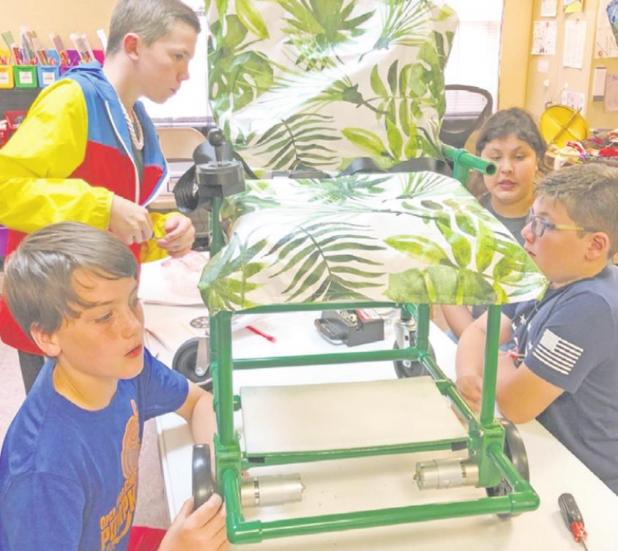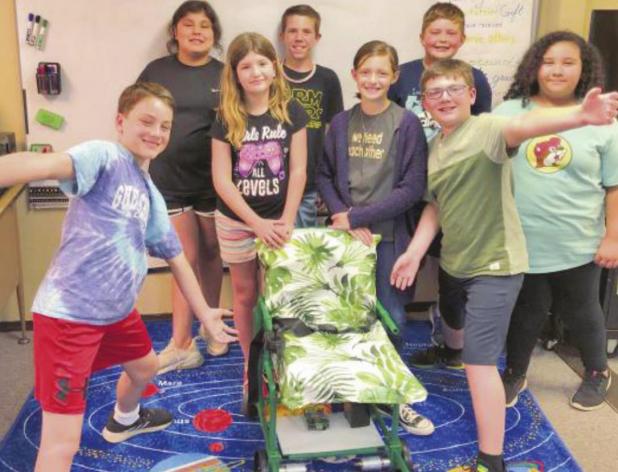

ODCS students build wheelchair for 7-year-old New York girl
For one month, fourth grade students at Open Door Christian School labored to make a difference in the life of a 7-year-old girl in New York, building a motorized wheelchair for her as part of their Science, Technology, Engineering, and Math (STEM) class.
ODCS STEM Coordinator Claire Meschkat said throughout the year the students learned about the engineering design process and applying math and science concepts to solve a problem, but she wanted to take that a step further for the fourth grade class.
“I wanted to give them a project that focused more on the aspect of how scientists and engineers don’t just build things, but do work to help others,” Meschkat wrote. “We found the Open Wheelchair Foundation that matches children in need to potential builders and provides the project design and instructions for free on their website. “
Meschkat said her sister worked for the hospital Scottish Rite for Children, building prosthetics for children and she wondered if there was a project the students could build at ODCS to help other children. ODCS Secretary LeAnn Stetson found the website for the Open Wheelchair Foundation and Meschkat emailed them to see about implementing the program for the students in the fourth grade class.
“They provide all of the resources as far as instructions for free, published on their website and then we just ordered all the supplies and built it,” Meschkat said.
The Open Wheelchair Foundation was founded in 2015 as a non-profit charitable organization which is dedicated to providing affordable wheelchairs to children by providing plans for an affordable do-it-yourself wheelchair. The wheelchairs are low cost, lightweight, easy to build and operate.
“We want to give children access to mobility and independence, without the prohibitive cost of buying a commercial wheelchair. Our goal is to bring this project to the world so that (…) anyone can experience the joy of mobility, no matter their physical state or economic status,” the foundation states on its website.
The class was matched through the foundation with Emmylou, a 7-year-old girl from New York, whose insurance would not cover the cost of purchasing a motorized wheelchair. According to Meschkat in a video presented for the project, Emmylou does physical therapy to make her legs stronger and uses specialized tools to build her muscles.
The students each wrote notes to Emmylou expressing their excitement to build her a wheelchair as a project.
Meschkat said the students at first did not think it was possible for them to build a wheelchair. They began working on the project at the beginning of April and used their skills learned from the classroom to build the design.
“They had to apply math skills in measuring the PVC tubing lengths and piece them correctly together. They then had to learn how to use different tools and understand electrical systems as they wired the motherboard, joystick, battery, and wheel motors together. The students also all learned how to sew and each made a cover for the seat cushion,” she wrote. The students were assigned to different teams for the project, such as a structural engineer, electrical engineer and design engineer teams. They had to apply to be in a certain position based on their previous experience and what interest they had in being a part of the project. The eight students involved in the project were Ean Arrell, Jackson Wagoner, Kolllin Green, Jack Menard, Aubrey Regalado, Daviney Cabrerra, Maddie Hearne and Evylette Martin.
They presented the final design for the project to the school Tuesday, May 25.
“(The class) demonstrated how the chair will provide more mobility and independence for the little girl we have been praying for as we built her chair. We will be mailing the wheelchair to her soon,” Meschkat wrote. The STEM class this year has also been involved with a weather balloon project which was built, launched, and measured by students from ODCS from Graham Municipal Airport in May.
Another project with a garden created at the school was the First the Seed Foundation Tomatosphere program, which uses students to investigate the effects of a space environment on the growth of food which will support long-term human space travel.
“(Tomatosphere) is a project from the First the Feed Foundation that partners with NASA to send tomato seeds up to space in one of their rockets or on the International Space Station. And then we were sent a packet of the tomato seeds that were flown into space, and we planted them in our school garden and took notes,” Meschkat said.
“So, we have tomato seeds that were from Earth and some that flew in space and we don’t know which ones are which, but our students were taking down notes and doing measurements and counting seeds sprouted to give that information back to scientists to help them be able to see how long-term space flight could affect humans and how we could sustain food production in space for future flights.”
